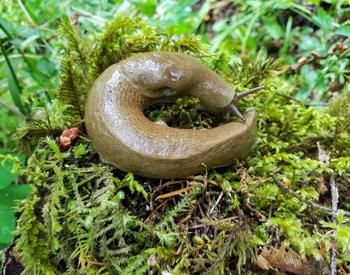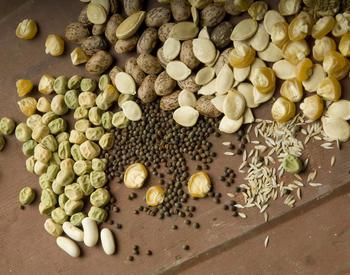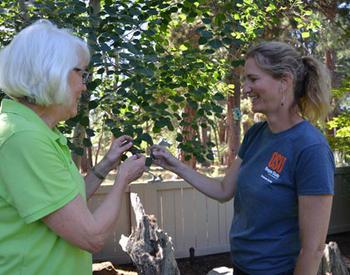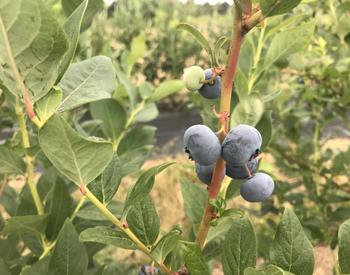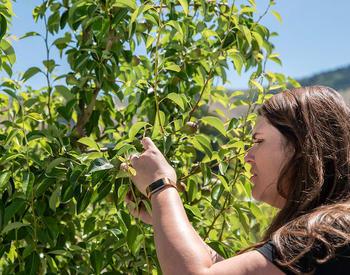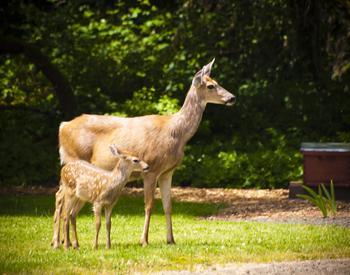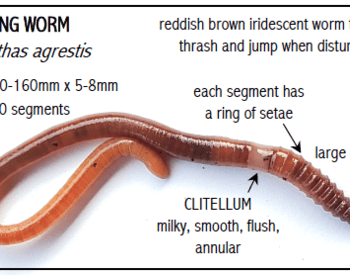Plants have external structures such as leaves, stems, roots, flowers, fruits and seeds. These structures are known as plant organs. Each organ is an organized group of tissues that works together to perform a specific function. Structures can be divided into two groups: sexual reproductive and vegetative.
Vegetative parts (figure 1) include roots, stems, shoot buds and leaves. They are not directly involved in sexual reproduction. Vegetative parts often are used in asexual forms of reproduction. Examples include cuttings, budding or grafting.
Roots
Roots are often overlooked, probably because they are less visible than the rest of the plant. However, it's important to understand plant root systems. They have a pronounced effect on a plant's size and vigor, method of propagation, adaptation to soil types and response to cultural practices and irrigation.
Roots typically originate from the lower portion of a plant or cutting. They have a root cap but lack nodes and never bear leaves or flowers directly.
Their principal functions are to absorb nutrients and moisture, anchor the plant in the soil, support the stem and store food. In some plants, they can be used for propagation.
Structure
Internally, there are three major parts of a root (figure 2).
- The meristem is at the tip and manufactures new cells. It is an area of cell division and growth.
- Behind the meristem is the zone of elongation. In this area, cells increase in size through food and water absorption. As they grow, they push the root through the soil.
- The zone of maturation is directly beneath the stem. Here, cells become specific tissues such as epidermis, cortex or vascular tissue.
A root's epidermis is its outermost layer of cells (figure 3). These cells are responsible for absorbing water and minerals dissolved in water.
Cortex cells are involved in moving water from the epidermis to the vascular tissue (xylem and phloem) and in storing food. Vascular tissue is located in the center of the root and conducts food and water.
Externally, there are two areas of importance: the root cap and the root hairs (figure 2). The root cap is the root's outermost tip. It consists of cells that are sloughed off as the root grows through the soil. Its function is to protect the root meristem.
Root hairs are delicate, elongated epidermal cells. They occur in a small zone just behind the root's growing tip. They generally appear as fine down to the naked eye. Their function is to increase the root's surface area and absorptive capacity.
Root hairs usually live one or two days. When a plant is transplanted, they are easily torn off or may dry out in the sun.
Many roots have a naturally occurring symbiotic (mutually beneficial) relationship with certain fungi. This relationship improves the plant's ability to absorb water and nutrients. This beneficial association is called mycorrhizae (fungus + root).
Types of roots
There are two major types of roots: primary and lateral.
- A primary root originates at the lower end of a seedling's embryo. Some primary roots continue to elongate downward, becomes the central feature of the root system and have limited secondary branching. These roots are called taproots (figure 4). Hickory and pecan trees, as well as carrots, have taproots.
- A lateral, or secondary, root is a side or branch root that arises from another root. If the primary root ceases to elongate, and numerous lateral roots develop, a fibrous root system is formed. These lateral roots branch repeatedly. They form the network of feeding roots found on most plants.
Some plants, such as grasses, naturally produce a fibrous root system. In other cases, severing a plant's taproot by undercutting it can encourage the plant to produce a fibrous root system. Nurseries use this technique with trees that naturally produce a taproot. Trees with a compact, fibrous root system are transplanted more successfully.
How roots grow
During early development, a seedling absorbs nutrients and moisture from the soil around the sprouting seed. A band of fertilizer several inches to each side and slightly below newly planted seeds helps early growth of most row crops.
As a plant becomes well established, the quantity and distribution of its roots strongly influence its ability to absorb moisture and nutrients.
For most plants, the majority of the absorbing (feeder) roots are located in the top 12 inches of soil. The soil environment in this region generally is best for root growth. Soil in this zone has a good balance of fertility, moisture, and air spaces.
The following factors are important in root growth:
- Roots in water-saturated soil do not grow well. Ultimately, they may die due to lack of oxygen.
- Roots penetrate much deeper in loose, well-drained soil than in heavy, poorly drained soil.
- A dense, compacted soil layer can restrict or terminate root growth.
- Container plants have a restricted area for root growth. They also are susceptible to cold damage because the limited amount of soil around their roots may not provide adequate insulation.
- In addition to growing downward, roots grow laterally. In fact, they often extend well beyond a plant's dripline. Keep this extensive root system in mind when disturbing the soil around existing trees and shrubs.
Roots as food
An enlarged root is the edible portion of several vegetable crops. Sweet potatoes are a swollen tuberous root. Carrots, parsnips, salsify and radishes are elongated taproots.
Stems
Stems support buds and leaves and carry water, minerals and food (photosynthates). The vascular system inside the stem forms a continuous pathway from the root, through the stem, and finally to the leaves. It is through this system that water and food products move.
Stem Terminology
- Shoot: A young stem (one year old or less) with leaves.
- Twig: A young stem (one year old or less) that is in the dormant winter stage (has no leaves).
- Branch: A stem that is more than one year old, typically with lateral stems radiating from it.
- Trunk: A woody plant's main stem.
Structure
Vascular system
This system consists of xylem, phloem, and vascular cambium. It can be thought of as a plant's plumbing. Xylem tubes conduct water and dissolved minerals. Phloem tubes carry food such as sugars.
The cambium is a layer of meristematic tissue that separates the xylem and phloem. It continuously produces new xylem and phloem cells. This new tissue is responsible for a stem's increase in girth.
The vascular cambium is important to gardeners. For example, the tissues on a grafted scion and rootstock need to line up. In addition, careless weed trimming can strip the bark off a tree. This can injure the cambium and cause the tree to die.
The vascular systems of monocots and dicots differ (figure 5). Both contain xylem and phloem, but these structures are arranged differently in each.
- In a monocot, the xylem and phloem are paired in bundles. These bundles are dispersed throughout the stem.
- In a dicot, the vascular system is said to be continuous because it forms rings inside the stem. The ring of phloem is near the bark and eventually becomes part of the bark in mature woody stems. The xylem forms the inner ring. In woody plants, it is called the sapwood and heartwood.
The difference in the vascular systems of monocots and dicots is of practical interest to gardeners. Some herbicides affect only one group. For example, 2,4-D kills only plants with a continuous vascular system (dicots). Nonselective herbicides, on the other hand (for example, glyphosate), kill plants regardless of their type of vascular system.
Nodes
A node is an area on a stem where buds are located (figure 6). It is a site of great cellular activity and growth. It is here that small buds develop into leaves, stems or flowers.
When pruning, it is important to locate a plant's nodes. Generally, you want to make a pruning cut just above, but not too close to, a node. Pruning in this manner encourages the buds at that node to begin development. Ultimately, it will form new stems or leaves.
The area between two nodes is called an internode. Its length depends on many factors, including genetics. Several other factors also can influence internode length:
- Reduced soil fertility decreases internode length. In contrast, an application of high-nitrogen fertilizer can greatly increase it.
- Lack of light increases internode length and causes a spindly stem. This situation is known as stretch, or etiolation. It often occurs in seedlings started indoors and in houseplants that do not get enough sunlight.
- Internode length also varies with the season. Early-season growth has long internodes. In. contrast, late-season growth generally has much shorter internodes.
- A stem's energy can be divided among three or four side stems, or it can be diverted into fruit growth and development. In this case, internode length is shortened.
- Plant growth regulator substances and herbicides also can influence internode length.
Types of stems
Stems may be long, with great distances between the leaves and buds. Examples include branches of trees and runners on strawberries. Other stems are compressed, with short distances between buds or leaves. Examples include crowns of strawberry plants, fruit spurs and African violets.
Stems commonly grow above ground. However, they sometimes grow below ground in the form of rhizomes, tubers, corms or bulbs. All stems must have buds or leaves to be classified as stem tissue.
Specialized aboveground stems
Some plants have specialized aboveground stems known as crowns, spurs or stolons (figure 7).
- Crowns (on strawberries, dandelions and African violets) are compressed stems. They have leaves and flowers on short internodes.
- Spurs are short, stubby, side stems that arise from a main stem. They are the fruit-bearing stems on pear, apple and cherry trees. If severe pruning is done close to fruit-bearing spurs, they can revert to nonfruiting stems. This would eliminate the year's potential fruit crop.
- Stolons are fleshy or semiwoody, elongated, horizontal stems. They often lie along the soil surface. Strawberry runners are stolons that have small leaves at the nodes. Roots develop from these nodes, and a daughter plant is formed. This type of vegetative reproduction is an easy way to increase the size of a strawberry patch. Spider plants also produce stolons, which ultimately can become entirely new plants.
Specialized belowground stems
Potato tubers, iris rhizomes and tulip bulbs are underground stems that store food for the plant (figure 8). It sometimes is difficult to distinguish between roots and stems, but one sure way is to look for nodes. Stems have nodes; roots do not.
In potato tubers, for example, the "eyes" are actually the stem's nodes. Each eye contains a cluster of buds. When growing potatoes from seed pieces, it is important that each piece contain at least one eye and be about the size of a golf ball. This will ensure enough energy for early growth of shoots and roots.
Rhizomes resemble stolons because they grow horizontally from plant to plant. Some rhizomes are compressed and fleshy (for example, iris). Others are slender and have elongated internodes (for example, bentgrass). Johnsongrass is an insidious weed principally because of the spreading capability of its rhizomes.
Tulips, lilies, daffodils and onions produce bulbs. These are shortened, compressed underground stems surrounded by fleshy scales (leaves) that envelop a central bud at the tip of the stem. In November, you can cut a tulip or daffodil bulb in half and see all of the flower parts in miniature.
After a bulb-producing plant flowers, its phloem transports food reserves from its leaves to the bulb's scales. When the bulb begins growing in the spring, it uses the stored food.
For this reason, it is important not to remove the leaves from daffodils, tulips and other bulb-producing plants until after they have turned yellow and withered. At that time, they have finished producing the food that will be used for next year's flowering.
There are two types of bulbs: tunicate and nontunicate (figure 8).
- Tunicate bulbs (for example, daffodils, tulips and onions) have a thin, papery covering. This covering is actually is a modified leaf. It helps protect the bulb from damage during digging and from drying out once it is out of the soil.
- Nontunicate bulbs (for example, lilies) do not have this papery covering. They are very susceptible to damage and drying out, so handle them very carefully.
Corms are another kind of belowground stem. Although both bulbs and corms are composed of stem tissue, they are not the same. Corms are shaped like bulbs but do not contain fleshy scales. A corm is a solid, swollen stem with dry, scalelike leaves. Gladiolus and crocuses produce corms.
Some plants (for example, tuberous begonias and cyclamen) produce a modified underground stem called a tuberous stem. These stems are short, flat and enlarged. Buds and shoots arise from the top (crown), and fibrous roots grow from the bottom.
Other plants (for example, dahlias and sweet potatoes) produce underground storage organs called tuberous roots. These organs are often are confused with bulbs and tubers. However, they are made up of root tissue, not stem tissue, and they have neither nodes nor internodes.
Stems and propagation
Stems often are used for vegetative plant propagation. Using sections of aboveground stems that contain nodes and internodes is an effective way to propagate many ornamental plants. These stem cuttings produce roots and, eventually, new plants.
Belowground stems also are good propagative tissues. You can divide rhizomes into pieces or remove small bulblets or cormels from their parent. Tubers can be cut into pieces containing eyes and nodes. All of these tissues will produce new plants.
Types of plants and their stems
Trees generally have one, but occasionally several, main trunks. Tree trunks usually are more than 12 feet tall when mature. In contrast, shrubs generally have several main stems, and they usually are less than 12 feet tall when mature.
Most fruit trees, ornamental trees and shrubs have woody stems. These stems contain large amounts of hardened xylem tissue in the central core (heartwood or sapwood).
Herbaceous or succulent stems contain only a little xylem tissue. They usually live for only one growing season. In perennial plants, new herbaceous stems develop from the crown (root-stem interface) each year.
Canes (figure 9a) are stems with relatively large pith (the central strength-giving tissue). They usually live only one or two years. Examples of plants with canes include roses, grapes, blackberries and raspberries. For fruit production, it is important to know which canes to prune, how to prune them and when to prune them.
A vine (figure 9b) is a plant with long, trailing stems. Some vines grow along the ground. Others must be supported by another plant or structure.
Twining vines circle a structure for support. Some circle clockwise (e.g., hops and honeysuckle). Others circle counterclockwise (for example, pole beans and Dutchman's pipe vine).
Some climbing vines are supported by aerial roots (for example, English ivy and poison ivy). Others are supported by slender tendrils that encircle a supporting object (for example, cucumbers, gourds, grapes, and passionflowers). Finally, some vines have tendrils with adhesive tips (for example, Virginia and Japanese creeper).
Stems as food
The edible portion of several cultivated plants is an enlarged, succulent stem. Examples include asparagus and kohlrabi. The edible parts of broccoli are composed of stem tissue, flower buds and a few small leaves. The edible tuber of a potato is a fleshy underground stem. And, although the name suggests otherwise, the edible part of cauliflower actually is proliferated stem tissue.
Buds
A bud is an undeveloped shoot from which leaves or flower parts grow. The buds of temperate-zone trees and shrubs typically have a protective outer layer of small, leathery scales. Annual plants and herbaceous perennials have naked buds with green, somewhat succulent, outer leaves.
Buds of many plants require exposure to a certain number of days below a critical temperature before resuming growth in the spring. This period, often referred to as rest, varies for different plants. Forsythia, for example, requires a relatively short rest period. Thus, it grows at the first sign of warm weather. Many peach varieties, on the other hand, require 700 to 1,000 hours of temperatures below 45°F.
During rest, dormant buds can withstand very low temperatures. After the rest period is satisfied, they are more susceptible to damage by cold temperatures or frost.
A leaf bud is composed of a short stem with embryonic leaves. Leaf buds often are less plump and more pointed than flower buds (figure 10a).
A flower bud is composed of a short stem with embryonic flower parts. In the case of fruit crops, flower buds sometimes are called fruit buds. This terminology is inaccurate, however. Although flowers have the potential to develop into fruits, they may not do so because of adverse weather conditions, lack of pollination or other unfavorable circumstances.
Location
Buds are named for their location on the stem (figure 10b). Terminal buds are located at the apex (tip) of a stem. Lateral (axillary) buds are located on the sides of a stem. They usually arise where a leaf meets a stem (an axil). In some instances, an axil contains more than one bud.
Adventitious buds arise at sites other than the terminal or axillary position. They may develop from roots, a stem internode, the edge of a leaf blade or callus tissue at the cut end of a stem or root. Adventitious buds allow stem, leaf and root cuttings to develop into entirely new plants.
Buds as food
Enlarged buds or parts of buds form the edible portion of some horticultural crops. Cabbage and head lettuce are examples of unusually large terminal buds. Succulent axillary buds are the edible part of Brussels sprouts. In the case of globe artichoke, the fleshy basal portion of the flower bud's bracts is eaten, along with its solid stem. Broccoli is the most important horticultural plant with edible flower buds. In this case, portions of the stem, as well as small leaves associated with the flower buds, are eaten.
Leaves
Function and structure
The principal function of leaves is to absorb sunlight to manufacture plant sugars. This process is called photosynthesis. Leaf surfaces are flattened to present a large area for efficient light absorption. The blade is the expanded thin structure on either side of the midrib. It usually is the largest, most conspicuous part of a leaf (figure 11).
A leaf is held away from its stem by a stemlike appendage called a petiole. The base of the petiole is attached to the stem at a node. Petioles vary in length or may be lacking entirely. If there is no petiole, the leaf blade is described as sessile or stalkless.
The node where a petiole meets a stem is called a leaf axil. The axil contains single buds or bud clusters, referred to as axillary buds. They may be either active or dormant. Under the right conditions, they will develop into stems or leaves.
A leaf blade is composed of several layers (figure 12a and figure 12b). On the top and bottom is a layer of thick, tough cells called the epidermis. Its primary function is to protect the other layers of leaf tissue.
The arrangement of epidermal cells determines the leaf's surface texture. Some leaves, such as those of African violet, have hairs (pubescence). These hairs are extensions of epidermal cells, and they make the leaves feel like velvet.
The cuticle is part of the epidermis. It produces a waxy layer called cutin, which protects the leaf from dehydration and disease.
The amount of cutin on a leaf increases with increasing light intensity. For this reason, when moving plants from shade into full sunlight, do so gradually over a period of a few weeks. This gradual exposure to sunlight allows the cutin layer to build up. The thicker cutting layer will protect the leaves from rapid water loss or sunscald.
The waxy cutin also repels water. For this reason, many pesticides contain a spray additive to help the product adhere to, or penetrate, the cutin layer.
Special epidermal cells called guard cells open and close in response to environmental stimuli, such as changes in weather and light. They regulate the passage of water, oxygen and carbon dioxide into and out of the leaf through tiny openings called stomata. In most species, the majority of the stomata are located on the underside of leaves.
Conditions that would cause plants to lose a lot of water (high temperature, low humidity) stimulate guard cells to close. In mild weather, they remain open. Guard cells also close in the absence of light.
Located between the upper and lower epidermis is the mesophyll. It is divided into a dense upper layer (palisade mesophyll) and a lower layer that contains lots of air space (spongy mesophyll). Located within the mesophyll cells are chloroplasts, where photosynthesis takes place.
Types of leaves
There are many kinds of plant leaves. The most common and conspicuous leaves are referred to as foliage. They are the primary location of photosynthesis. However, there are many other types of modified leaves.
- Scale leaves (cataphylls) are found on rhizomes and buds, which they enclose and protect.
- Seed leaves (cotyledons) are found on embryonic plants. They store food for the developing seedling.
- Spines and tendrils, such as those found on barberry and pea plants, protect a plant or help support its stems.
- Storage leaves, such as those on bulbous plants and succulents, store food.
- Bracts often are brightly colored. For example, the showy structures on dogwoods and poinsettias are bracts, not petals.
Venation
The vascular bundles of xylem and phloem extend from the stem, through the petiole and into the leaf blade as veins. The term venation refers to how veins are distributed in the blade. There are two principal types of venation: parallel-veined and net-veined (figure 13).
In parallel-veined leaves, numerous veins run essentially parallel to each other. They are connected laterally by minute, straight veinlets. Parallel-veined leaves occur most often on monocotyledonous plants.
The most common type of parallel veining is found in plants of the grass family. These plants' veins run from the leaf's base to its apex. Another type of parallel venation is found in plants such as banana, calla and pickerelweed. In these plants, veins run laterally from the midrib.
In net-veined leaves (also called reticulate-veined), veins branch from the main rib or ribs and subdivide into finer veinlets. These veinlets then unite in a complicated network. This system of enmeshed veins makes the leaf more resistant to tearing than does a parallel vein structure. Net-veined leaves occur on dicotyledonous plants.
Net venation may be either pinnate or palmate. In pinnate venation, the veins extend laterally from the midrib to the edge. Examples include apples, cherries and peaches. In palmate venation, the principal veins extend outward, like the ribs of a fan, from the base of the leaf blade. Examples include grapes and maples.
Leaves as plant identifiers
Leaves are useful for plant identification. A leaf's venation (figure 13), blade and margin shapes (figures 14 and 15) and apex and base shapes (figure 16) can be important identifying characteristics.
Leaf type (figure 17) also is important for identification. There are two types of leaves: simple and compound. In simple leaves, the leaf blade is a single, continuous unit. Compound leaves are composed of several separate leaflets arising from the same petiole. Some leaves are doubly compound. Leaf type can be confusing, because a deeply lobed simple leaf may look like a compound leaf.
Leaf arrangement along a stem also is used in plant identification (figure 18). There are four types of leaf arrangement:
- Opposite leaves are positioned across the stem from each other. There are two leaves at each node.
- Alternate (spiral) leaves are arranged in alternate steps along the stem. Each node has only one leaf.
- Whorled leaves are arranged in circles along the stem.
- Rosulate leaves are arranged in a rosette around a stem. They have extremely short nodes.
Leaves as food
The leaf blade is the principal edible part of several horticultural crops. Examples include chives, collards, dandelions, endives, kale, leaf lettuce, mustard, parsley, spinach, Swiss chard and other greens. The edible part of leeks, onions and Florence fennel is a cluster of fleshy leaf bases. The petiole is the edible product in celery and rhubarb.

